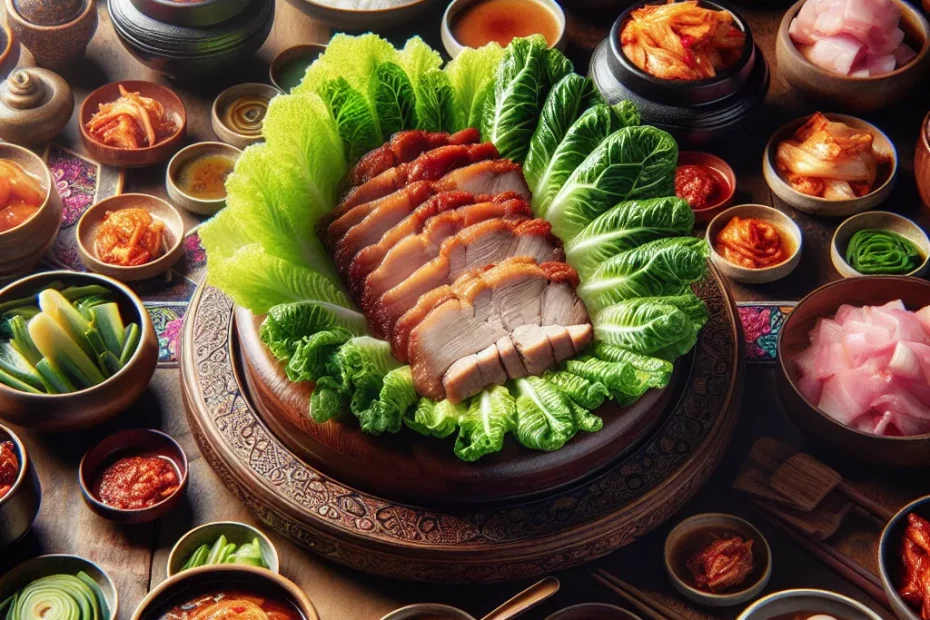Welcome to the world of Bossam, where the delightful flavors of Korea come together in a mouthwatering harmony! Today, we embark on a journey to explore the origins and history of this beloved dish, uncover the essential ingredients for crafting perfect steamed pork wraps, and master the art of creating the delectable Ssamjang sauce. Join me as we discover the perfect pairings of Bossam with various types of kimchi, adding layers of complexity to each bite. Get ready to indulge in a culinary adventure that will tantalize your taste buds and leave you craving for more. Let’s dive into the rich tapestry of flavors and traditions that make Bossam a true Korean culinary gem!

Discovering Bossam’s Origins and History
Have you ever tried Bossam, the delightful Korean dish that combines succulent steamed pork, spicy kimchi, and flavorful ssamjang? Let’s delve into the origins and history of this beloved dish that has been satisfying taste buds for generations! 🌟
The History of Bossam
Bossam, which translates to “wrapped” or “wrapped food” in Korean, has a rich history dating back to the Joseon Dynasty. During this time, Bossam was considered a royal dish, enjoyed by the aristocrats and nobles of the era. The dish was often served during special occasions and banquets, showcasing the luxurious and exquisite flavors of the steamed pork.
The Star of Bossam
The star of the show in Bossam is the pork belly, which is carefully boiled with various seasonings such as garlic, ginger, and green onions to enhance its natural flavors. The pork is then thinly sliced and served with an array of side dishes, including fresh lettuce leaves, kimchi, and ssamjang, a spicy and savory dipping sauce made from fermented soybean paste, chili paste, and other ingredients.
The Art of Wrapping
One of the key elements of Bossam is the art of wrapping. Diners create their own wraps by placing a piece of pork belly, kimchi, and ssamjang onto a lettuce leaf, then folding it into a neat bundle before taking a satisfying bite. The combination of tender pork, crunchy kimchi, and zesty ssamjang creates a harmonious explosion of flavors in every mouthful. 🥢🥬
Evolution of Bossam
Over the years, Bossam has evolved to become a popular comfort food enjoyed by people of all ages in Korea. It is often served at family gatherings, celebrations, and casual meals, bringing people together to share in the joy of good food and good company. The dish has also gained international recognition, with restaurants around the world serving their own take on this classic Korean favorite.
So, the next time you’re craving a taste of Korea, why not indulge in a plate of Bossam? Whether you’re a fan of spicy flavors or simply enjoy the experience of wrapping your own delicious bites, Bossam is sure to satisfy your cravings and leave you wanting more. Experience the tradition, history, and flavors of Bossam for yourself and embark on a culinary journey like no other! 🌏🍴
Bossam: a dish that transcends time, bringing together tradition, flavor, and the joy of sharing good food with loved ones. Dive into a world of taste and culture with every bite of this iconic Korean delicacy! 🇰🇷👨🍳
Ingredients for Making Flavorful Steamed Pork Wraps
Are you ready to embark on a culinary journey to savor the delightful flavors of Korea? Let’s dive into the world of Bossam, a traditional Korean dish that will tantalize your taste buds and leave you craving for more! To create the perfect Bossam experience at home, you’ll need a few key ingredients that will elevate the flavors of the steamed pork wraps to a whole new level.
Key Ingredients:
First and foremost, you’ll need a generous portion of pork belly. The marbling of the pork belly is crucial in ensuring that the meat remains juicy and tender after steaming. Make sure to select a high-quality cut with just the right amount of fat to meat ratio for that melt-in-your-mouth texture that Bossam is famous for. 🐷
Aromatic Ingredients:
Next, gather an assortment of aromatic ingredients to infuse the pork with rich flavors. Garlic, ginger, scallions, and onions are essential for creating a fragrant and savory broth in which the pork will be cooked. These ingredients will not only add depth to the dish but also create a mouthwatering aroma that will fill your kitchen as the pork steams to perfection. 🌿
Special Dipping Sauce – Ssamjang:
To achieve that signature umami taste of Bossam, you’ll need to prepare a special dipping sauce called Ssamjang. This traditional Korean condiment is a blend of fermented soybean paste, chili paste, sesame oil, garlic, and other seasonings. The combination of savory, spicy, and slightly sweet flavors in Ssamjang perfectly complements the tender steamed pork, creating a harmonious balance of tastes in every bite. 🌶️
Iconic Side Dish – Kimchi:
Of course, no Bossam experience is complete without the iconic side dish of kimchi. The tangy and spicy flavors of kimchi cut through the richness of the pork, providing a refreshing and crunchy contrast to the soft steamed meat. Whether you prefer traditional napa cabbage kimchi or the radish variety, the addition of this fermented delicacy will take your Bossam feast to the next level. 🥬
Wrapping Greens – Lettuce and Perilla Leaves:
Lastly, don’t forget to prepare a platter of fresh lettuce leaves and perilla leaves, also known as kkaennip. These vibrant greens will serve as the perfect vessel for wrapping the succulent pork, kimchi, and Ssamjang into delicious bundles of flavor. The crisp texture of the lettuce and the unique herbal notes of perilla leaves will add a refreshing element to each bite, making every mouthful a delightful experience. 🥬
Now that you have all the ingredients at your disposal, it’s time to roll up your sleeves and start creating your own masterpiece of Bossam at home. Get ready to impress your family and friends with a feast that celebrates the vibrant and diverse flavors of Korean cuisine. Let the aroma of steamed pork and the spicy kick of kimchi transport you to the bustling streets of Seoul, where every bite tells a story of tradition, flavor, and culinary craftsmanship. Enjoy every moment of the cooking process, and savor every bite of the delectable Bossam that you have created with love and passion. Cheers to a culinary adventure that will surely leave a lasting impression on your taste buds! 🍽️
Perfecting the Art of Ssamjang Sauce
Are you ready to elevate your Korean culinary skills to the next level? Look no further than mastering the art of making Ssamjang sauce! This flavorful and versatile sauce is a staple in Korean cuisine, especially when enjoying dishes like Bossam, where the rich, savory sauce perfectly complements the tender steamed pork wraps.
The Essence of Ssamjang
Ssamjang is a unique blend of fermented soybean paste (doenjang), red chili paste (gochujang), sesame oil, garlic, and other seasonings. The key to perfecting Ssamjang lies in achieving the ideal balance of flavors – the umami from the soybean paste, the heat from the chili paste, the nuttiness from the sesame oil, and the aromatic garlic all coming together harmoniously.
Creating the Perfect Ssamjang Sauce
To create the perfect Ssamjang sauce, start with 1/4 cup of doenjang and 2 tablespoons of gochujang. Add 1 tablespoon of sesame oil for that distinctive nutty flavor, 2 cloves of minced garlic for a punch of aroma, and a teaspoon of sugar to balance out the saltiness. Mix everything together until smooth and well combined.
But don’t be afraid to get creative with your Ssamjang! You can customize the sauce to your taste by adding ingredients like chopped green onions, toasted sesame seeds, or even a splash of rice vinegar for a tangy twist. The beauty of Ssamjang lies in its versatility, so feel free to experiment and make it your own.
Serving Ssamjang with Bossam
When serving Ssamjang with Bossam, don’t forget to prepare a platter of fresh lettuce leaves, kimchi, and thinly sliced garlic and chili peppers. To enjoy, simply take a piece of the steamed pork, smear it with a generous amount of Ssamjang, add your favorite toppings, wrap it in a crisp lettuce leaf, and indulge in the explosion of flavors with each bite!
So, what are you waiting for? Grab your ingredients, unleash your inner chef, and let’s perfect the art of Ssamjang sauce together! Your taste buds will thank you for it~!
Pairing Bossam with Different Types of Kimchi
Are you ready to elevate your bossam experience to the next level? One of the best ways to enjoy this delicious Korean dish is by pairing it with various types of kimchi. Kimchi, a traditional fermented side dish made with vegetables and a variety of seasonings, adds a burst of flavor and texture to each bite of bossam. Let’s explore some exciting kimchi options to pair with your steamed pork wraps!
Traditional Napa Cabbage Kimchi
The classic choice for many, traditional napa cabbage kimchi offers a perfect balance of tangy, spicy, and umami flavors. Its crunchy texture and bold taste complement the rich and savory pork belly in bossam, creating a harmonious blend of tastes that will leave your taste buds dancing with joy.
Radish Kimchi (Kkakdugi)
For those who prefer a milder kimchi option, radish kimchi, also known as kkakdugi, is a fantastic choice. The crisp and slightly sweet flavor of the radish kimchi provides a refreshing contrast to the fatty pork, making each bite a delightful experience.
Young Radish Kimchi (Yeolmu Kimchi)
If you’re looking for a kimchi with a unique twist, try pairing bossam with young radish kimchi, also known as yeolmu kimchi. This type of kimchi is made with young radish greens and has a fresh, slightly tangy taste that pairs beautifully with the tender pork in bossam.
White Kimchi (Baek Kimchi)
White kimchi, or baek kimchi, is a mild and refreshing variation of the traditional red kimchi. Made without chili pepper flakes, white kimchi has a subtle flavor profile with hints of sweetness and a slightly sour tang. The delicate flavors of white kimchi can complement the rich flavors of bossam without overpowering them.
Water Kimchi (Mul Kimchi)
If you’re looking for a kimchi that is light and refreshing, water kimchi, or mul kimchi, is an excellent choice. Made with a brine base instead of the traditional chili paste, water kimchi has a clean and crisp taste that can cleanse your palate between bites of bossam, allowing you to fully appreciate the layers of flavors in this dish.
Pairing bossam with different types of kimchi is a fantastic way to explore the diverse flavors of Korean cuisine. Whether you prefer the spicy kick of traditional kimchi or the subtle nuances of white kimchi, there is a kimchi option to suit every palate. So, gather your friends and family, wrap up some bossam with your favorite kimchi, and enjoy a flavorful and satisfying meal that celebrates the rich culinary heritage of Korea! 🍽️🇰🇷
In conclusion, Bossam is a delightful dish that embodies the rich flavors of Korean cuisine. Whether you’re savoring the tender steamed pork wraps, crafting the perfect Ssamjang sauce, or pairing it with various types of kimchi, Bossam offers a culinary experience that is both satisfying and memorable. The history and origins of Bossam add an extra layer of appreciation to this beloved dish, making it a must-try for food enthusiasts looking to explore the diverse tastes of Korea. So, gather your loved ones, prepare a feast of Bossam, and enjoy a truly authentic Korean dining experience that will leave you craving for more!
